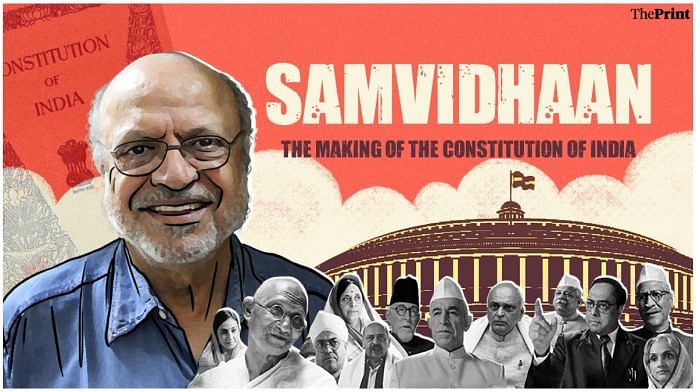New Delhi: At 79, when he could have hung up his boots, renowned filmmaker Shyam Benegal took up a new challenge: to create a 10-hour long mini-series based on the debates in the Constituent Assembly debates (1946-49).
‘Samvidhaan: The Making of the Constitution of India’. The series showcases just what it was set out to do: it crunches down three years of debates on the Indian Constitution into a format that young India consumes. Dubbed in 14 Indian languages and first telecast on Rajya Sabha TV every Sunday in 2014, the show has actor Swara Bhaskar leading the audience through hours of debates into what finally became the Indian Constitution — the document that became the identity of independent India.
The series, which can still be accessed on YouTube, marked Benegal’s return to the small screen after shows like Yatra (based on Indian Railways’ journey) and Bharat Ek Khoj (based on Jawaharlal Nehru’s book — Discovery of India). But the veteran director believed it was his prior experience in the theatre and his tenure as an MP that inspired him to create Samvidhaan. He also described the show as an “evolution from what’s gone before”, referring to his previous TV shows.
It wasn’t all smooth sailing: the biggest challenges, according to Benegal, were getting the cast right, ensuring that none of the characters seem caricaturish, and most importantly, having an authentic yet engaging script.
“We had to be on the straight and narrow,” the filmmaker told Hindustan Times in 2014.
About three-quarters of the show is shot inside the Assembly.
The actors who brought to life the prominent faces of India’s freedom struggle were Tom Alter as Maulana Azad, Utkarsh Mazumdar as Sardar Vallabhbhai Patel, Ila Arun as Hansa Mehta, Rahul Singh as Acharya Kriplani, Amit Behl as C. Rajagopalachari, Rajeshwari Sachdev as Amrit Kaur, Neeraj Kabi as Mahatma Gandhi, K.K. Raina as K.M. Munshi, Sachin Khedekar as Bhimrao Ambedkar, Rajendra Gupta as Rajendra Prasad, and Dalip Tahil as Jawaharlal Nehru.
Atul Tiwari, who played Govind Ballabh Pant, also co-wrote the script with legendary dialogue writer Shama Zaidi, whose educationist and politician father Bashir Husain Zaidi was a member of the Assembly.
Tiwari had said in 2013 that the show borrowed dialogues “verbatim as spoken on the floor of the Assembly”.
According to Gurdeep Singh Sappal, CEO of Rajya Sabha TV, the concept to make a show chronicling the Indian Constitution’s framework came from former vice president Hamid Ansari.
Also Read: Two RSS comics that captured the imagination of kids & teenagers, inspired them to join outfit
‘A long film’
The series boasts of over a crore views on YouTube for its episodes and was highly appreciated at the time of its release. Vaibhavi Sharma, 28, an economics graduate from Delhi University recalls it as it was broadcast on Rajya Sabha TV.
“My father has been a professor and an ardent follower of Dr. Ambedkar so when the show was announced, you can imagine the skepticism and anticipation in my household. But to our surprise, the show was well crafted,” Sharma told ThePrint.
She said although there were no new revelations from the historical standpoint, it was refreshing to see the meticulous research that had gone into its making.
“More than a 10-episode series. It would have felt like a 10-hour long film had we watched it one go,” she said.
Srishti Guleria, 21, an M.A. in Political Science student at Ambedkar University, discovered the show during the pandemic.
“I was surprised to see that not many around me knew about its existence especially when it is so well-made. To profile a country like India that is so diverse and, unlike many other countries, is no child’s play,” she said.
Also Read: iPhone 1 — A ‘revolutionary’ smartphone that debuted at the 2007 Oscars
(Edited by Uttara Ramaswamy)



